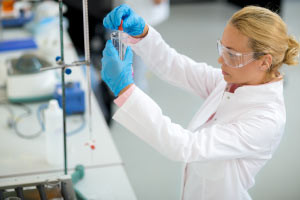This course on the fundamentals of chemistry will first discuss the periodic table and the groups of elements. You will study chemistry symbols, atoms, molecules, elements, chemical bonds, and compounds. You will also cover ions and particles, and study the three states of matter: liquids, gases, and solids. You will look into mixtures, and discuss the two types of corrosive substances: acids and bases. In addition, this course will discuss PH scales, PH meters, and acid-base indicators.
Mixtures can be separated using different techniques. This course will discuss chromatography (which is used to separate mixtures of substances into their components), decanting (which is the separation of liquids from solids by gradual pouring), dissolving, solidification, and precipitation. You will also look into evaporation, distillation which purifies a liquid by heating or cooling, and filtration which separates solids from liquids using a medium. You will also study sublimation which is the transition of a substance directly from the solid to the gas phase.
Chemistry is also known as the central science because it joins together biology and medicine, physics and mathematics, and the earth and environmental sciences. By the end of this course, you will have gained a deeper understanding of the behavior of atoms, molecules, and ions, all of which determine the very world we live in. So, check out this course today and start gaining a clearer understanding of the fundamentals of chemistry, all for free.
Chemistry is also known as the central science because it joins together biology and medicine, physics and mathematics, and the earth and environmental sciences. By the end of this course, you will have gained a deeper understanding of the behavior of atoms, molecules, and ions, all of which determines the very world we live in. So, check out this course today and start gaining a clearer understanding of the fundamentals of chemistry, all for free.
What You Will Learn In This Free Course
View All Learning Outcomes View Less All Alison courses are free to enrol, study, and complete. To successfully complete this Certificate course and become an Alison Graduate, you need to achieve 80% or higher in each course assessment.
Once you have completed this Certificate course, you have the option to acquire an official Certificate, which is a great way to share your achievement with the world.
Your Alison certificate is:
- Ideal for sharing with potential employers.
- Great for your CV, professional social media profiles, and job applications.
- An indication of your commitment to continuously learn, upskill, and achieve high results.
- An incentive for you to continue empowering yourself through lifelong learning.
Alison offers 2 types of Certificate for completed Certificate courses:
- Digital Certificate: a downloadable Certificate in PDF format immediately available to you when you complete your purchase.
- Physical Certificate: a physical version of your officially branded and security-marked Certificate
All Certificate are available to purchase through the Alison Shop. For more information on purchasing Alison Certificate, please visit our FAQs. If you decide not to purchase your Alison Certificate, you can still demonstrate your achievement by sharing your Learner Record or Learner Achievement Verification, both of which are accessible from your Account Settings.











 Avg. Hours
Avg. Hours  CPD Accredited
CPD Accredited 
 Total XP:
Total XP: 
 Knowledge & Skills You Will Learn
Knowledge & Skills You Will Learn 







